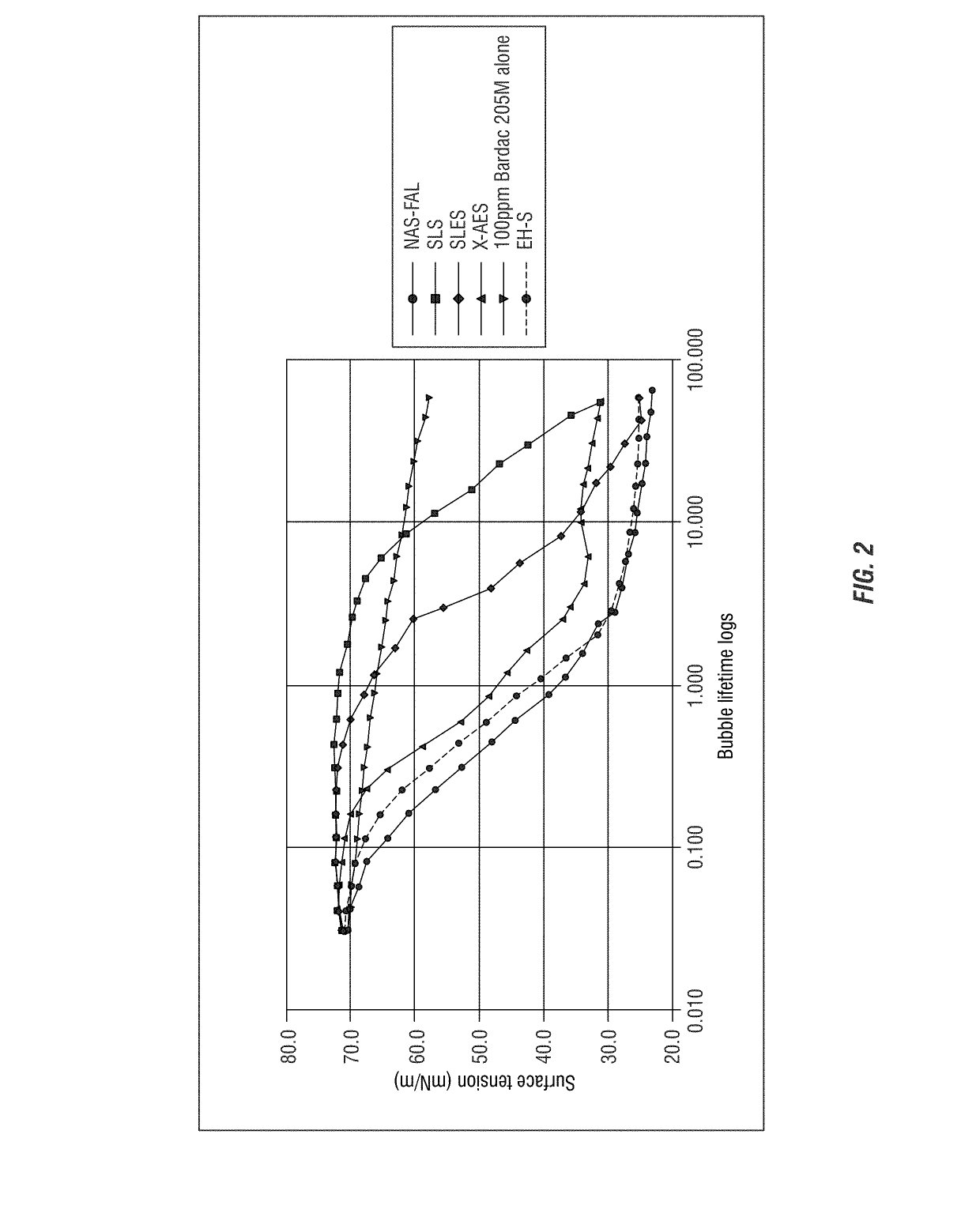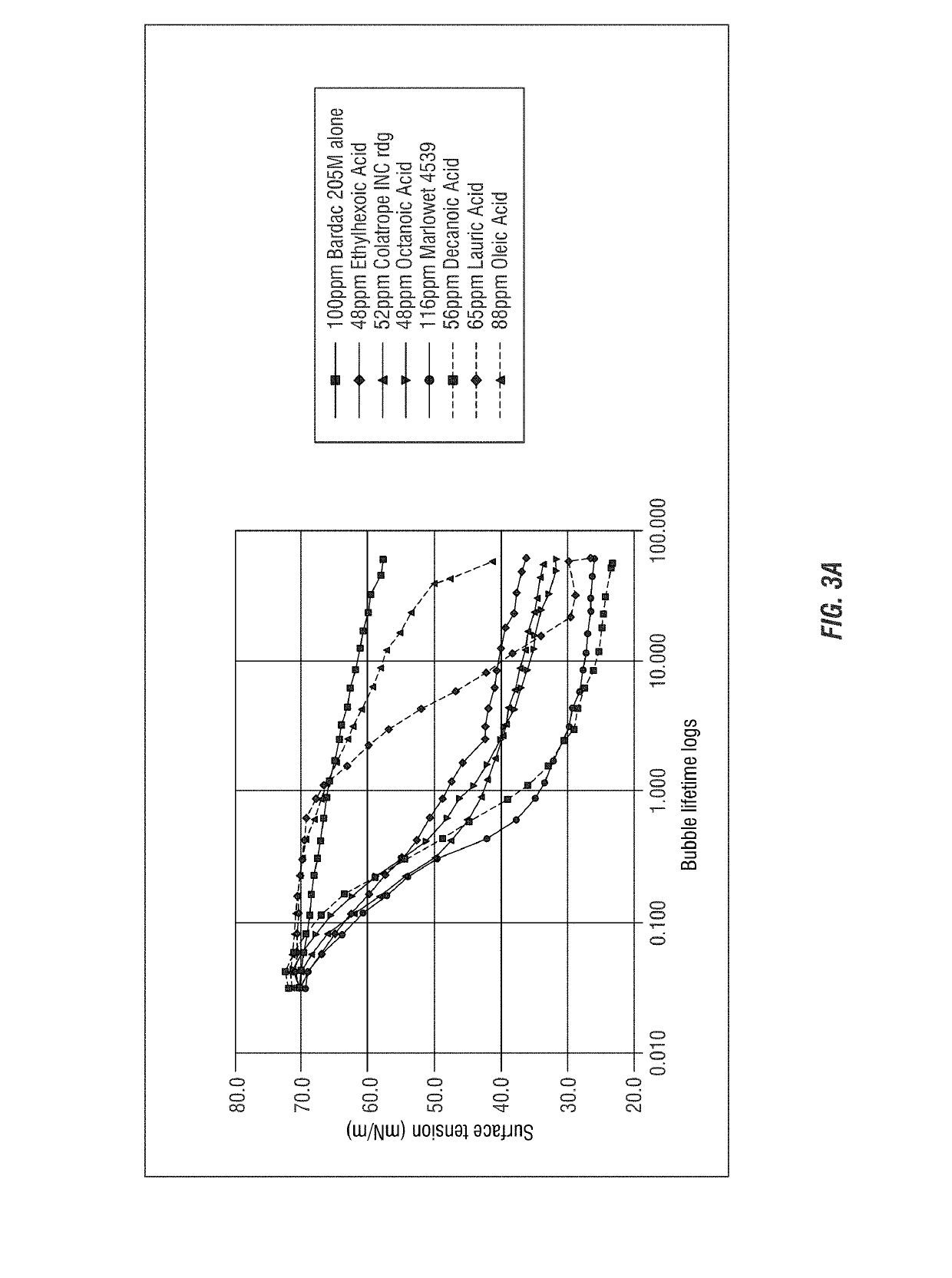Interaction between antimicrobial quaternary compounds and anionic surfactants
a technology of anionic surfactants and quaternary compounds, which is applied in the field of antimicrobial compositions, can solve the problems of ineffective ph and low temperature, and difficulty in retaining kill efficacy, and achieves the effect of synergistic surface activity
- Summary
- Abstract
- Description
- Claims
- Application Information
AI Technical Summary
Benefits of technology
Problems solved by technology
Method used
Image
Examples
example 1
[0295]Dynamic Surface Tension of Bardac 205M and Anionic Surfactant
[0296]The SITA science line t60 measures the dynamic surface tension of liquids up to the semi-static range. Air bubbles are generated from a capillary with known radius. The bubble pressure is measured as a function of bubble life time, which can be correlated to the surface tension according to the Young-Laplace equation. Dynamic surface tension provides insight in to the dynamic behavior of surfactants and other surface active compounds under dynamic conditions, i.e. how quick surfactants can reach a surface. The dynamic surface tension behavior of surfactants is particularly important in applications where a quick response of surfactant is required, for example, in short rinse cycles of automated dishwashing.
Apparatus and Materials
[0297]1. SITA T60 (Sita Messtechnik, Germany)[0298]2. Oil bath with stir bar[0299]3. Heating and stirring plate[0300]4. Glass beakers[0301]5. Glass vials (20 mL)
[0302]The SITA science l...
example 2
[0306]Dynamic Surface Tension of Bardac 205M and Anionic Sulfate Surfactant Blends
[0307]To further examine the surface activity of a mole: mole ratio of quaternary ammonium compound with different anionic sulfate surfactants, the procedure described in Example 1 was followed. Bardac 205M as described above was combined each with SLS (sodium lauryl sulfate), SLES (sodium lauryl ether sulfate), X-AES (C12-4—(PO)16-(EO)2-sulfate available from Huntsman Chemical), and Stepanol EH-S (Sodium 2-ETHYL HEXYL SULFATE available from Stepan) at a mole: mole ratio. The results are provided in FIG. 2.
[0308]The results shown in FIG. 2 demonstrate that the combinations exhibit chain length dependent surface activity as compared to the quaternary ammonium compound (Bardac 205M) alone (at this molar ratio). For example, Bardac 205M in combination with EH-S or X-AES or NAS-FAL all showed a rapid increase in surface activity. Whereas, the Bardac 205M, SLS or SLES blends resulted in an overall increase ...
example 3
[0310]Dynamic Surface Tension of Mole-Mole Ratio Bardac 205M with Anionic Carboxylate Surfactants
[0311]The dynamic surface tension of a mole: mole ratio of quaternary ammonium compound with different anionic carboxylate surfactants were tested following the procedure of Example 1. The following solutions were prepared: Bardac 205M at a concentration of 100 ppm as described above was combined each with 48 ppm ethylhexoic acid, 52 ppm Colatrope INC (sodium alkanoate available from Colonial Chemical Inc.), 48 ppm octanoic acid, 116 ppm Marolwet4539 SLS (C9-alcohol polyethylene glycol ether carboxylic acid available from Sasol), 56 ppm decanoic acid, and 65 ppm lauric acid at a mole: mole ratio. These data are provided in FIG. 3.
[0312]The results shown in FIG. 3A demonstrate that the combinations of carboxylated anionic surfactants and quaternary ammonium compounds have reduced surface activity as compared to the quaternary ammonium compound (Bardac 205M) alone. The combination of Barda...
PUM
 Login to View More
Login to View More Abstract
Description
Claims
Application Information
 Login to View More
Login to View More - R&D
- Intellectual Property
- Life Sciences
- Materials
- Tech Scout
- Unparalleled Data Quality
- Higher Quality Content
- 60% Fewer Hallucinations
Browse by: Latest US Patents, China's latest patents, Technical Efficacy Thesaurus, Application Domain, Technology Topic, Popular Technical Reports.
© 2025 PatSnap. All rights reserved.Legal|Privacy policy|Modern Slavery Act Transparency Statement|Sitemap|About US| Contact US: help@patsnap.com



